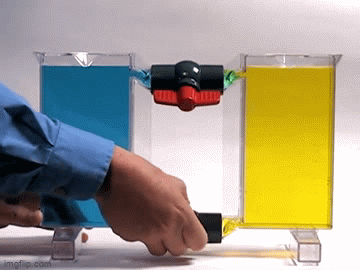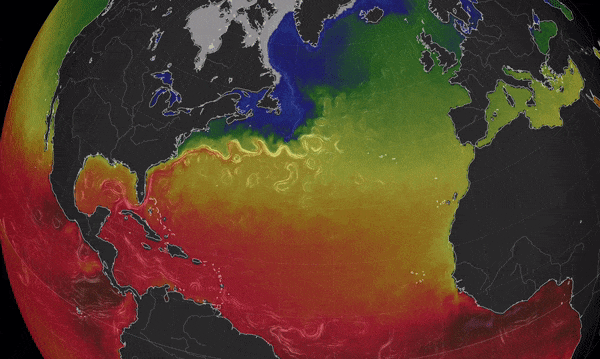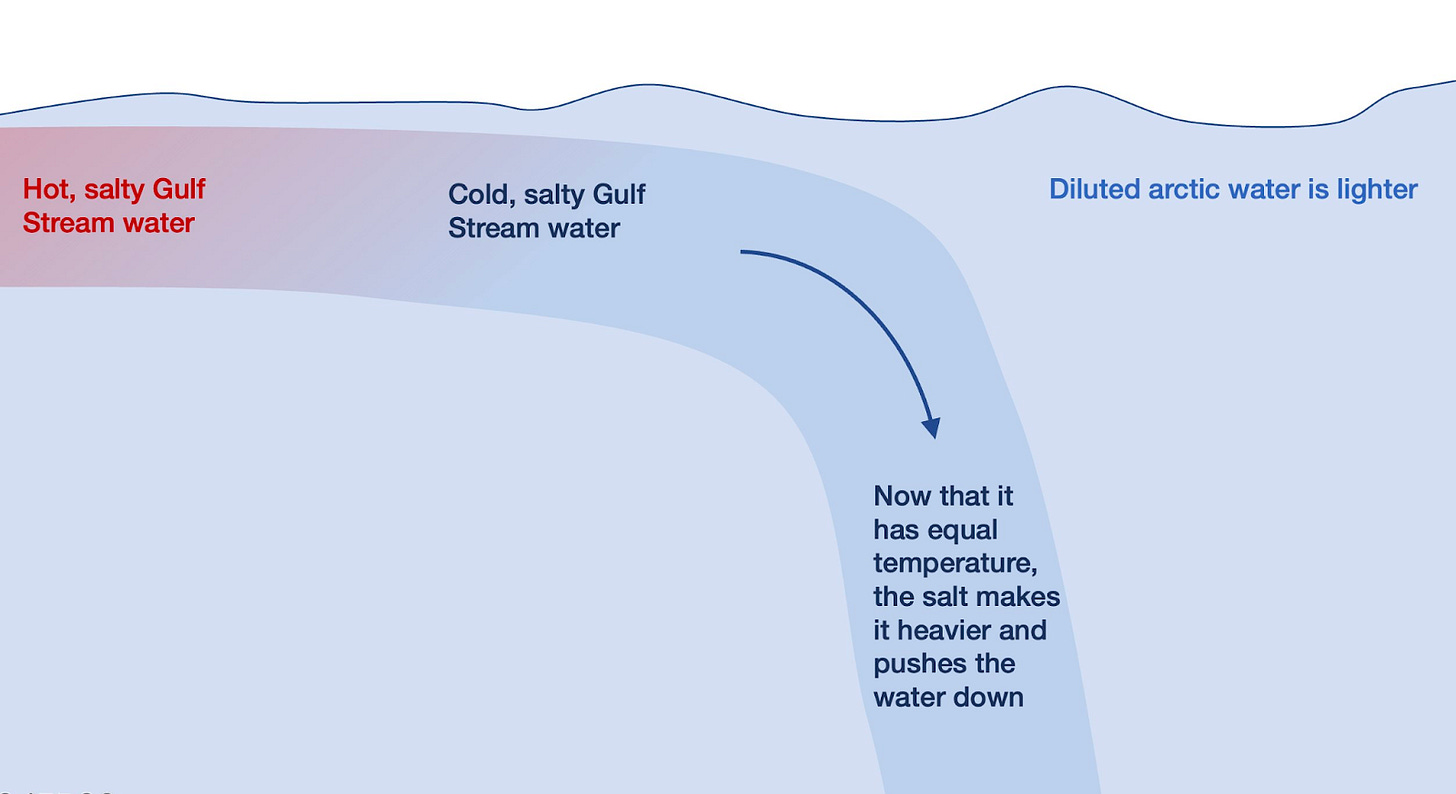You know why tropical waters are so transparent?
Because they’re dead.
Compare that to this water:
Before looking into this, I never thought about why tropical water was transparent and polar water was opaque. I assumed it was because of the temperature, maybe depth. But obviously, it’s not, since you can cool water and it doesn’t become opaque, and in the image above you can see underwater body parts of whales become blurry even if the rest of the body is above the surface.
The answer is in this map:

Blue means there’s no phytoplankton, which are like the plants of the sea1.
If there’s no phytoplankton, there’s no zooplankton to eat it.
If there’s no zooplankton, there’s no krill to eat it. No small fish to eat the krill. No big fish to eat the small ones.
So the areas without phytoplankton don’t have much life at all.
This is why you need to watch all your documentaries about sea life with a jacket on, feeling the overabundant ice: The phytoplankton grows more up north, so all animals go there to feed.
This might sound counterintuitive: “When I’m at a tropical beach, I see plenty of animals!”
That’s true. But if you look back at the map above, this only happens near the coasts. In the open seas, most tropical oceans are as empty as deserts.

So why are they barren deserts? Nutrients.
Plants2 need heat, water, and nutrients. In the ocean, they have water. And since the ocean is not frozen, the heat is good enough. What they don’t always have is nutrients. Why is that?
Nutrients normally fall to the bottom of the ocean, alone or inside animals or their droppings. You need currents to bring them back up. But around the equator, you don’t have these currents. Nutrients fall to the bottom and remain there. Why? Because of the heat from the sun.
As the sun warms up the top of the ocean, the water there becomes lighter. This is normal: Everything that is hotter is also lighter.
When something’s hot, it means its atoms have energy, so they hit against each other, requiring more space. If the same amount of atoms uses more space, it means you have more volume for the same mass, so you’re lighter.
The result is that hot water goes to the top and cold water goes to the bottom.

In tropical oceans, the same thing happens: Water at the top is hot, so it doesn’t mix with cold water from the bottom.
The result is nutrients remain in the cold depths, and a hot desert of water stays at the top.
Then why do waters farther away from the equator have more phytoplankton? It means they have more nutrients. Why?
Because surface water is much colder there. The closer the temperature, the closer the density, and the more they can mix. Waters far north or far south are cold enough that they can mix easily.
This is why for example in the Baltic Sea we have phytoplankton blooms:

Colder water mixes nutrients better, phytoplankton eats them and reproduces, triggering the food chain.
This is one of the reasons why around 80% of the humans above the 60th parallel live in this small area in Europe:
If you zoom in:

But it’s not just the Nordic countries. If you go back to the global map, you’ll see that Europe is much farther north than nearly all other centers of population. This, as you might know, is due to the Gulf Stream.
The warm water without nutrients from the Caribbean flows northeast to Europe, bringing its heat with it. As it does, it becomes colder. Eventually, it reaches the same temperature as the rest of the water. When that happens, there isn’t a difference in density due to temperature anymore, and the top water sinks, mixing with bottom water, and bringing nutrients to the top, which then feeds the phytoplankton.
But hold on a second, why does the top water sink? Is it enough to be the same density? Shouldn’t it be heavier?
Yes! Gulf Stream water is heavier indeed at that point because of salt.
At the equator, heat evaporates water from the top of the ocean. Some of that water rains back there, but a lot rains on continents, reducing the water compared to the salt. This hot water is salty.
In the northern ocean, there's little evaporation because it’s colder. There is, however, lots of rain, rivers dropping their water into the ocean, and ice melting. All these sources of fresh water dilute the salt.
Now what's heavier: normal water, or normal water plus added salt? The one with added salt, right? So with equal temperatures, the saltier water will be heavier and will fall.
This is what happens to the Gulf Stream water: Early on it’s hot and salty. Hot makes it light, but salty makes it heavier. On balance, it’s lighter than the water at the bottom of the ocean.
But as the temperature drops, now the lightness coming from heat disappears, and only the heaviness coming from salt remains. This makes this water heavier, and it sinks.
The Fear about Global Warming
One of the concerns that scientists have is that Global Warming might freeze Europe. Why is that?
For example, with ice caps melting, a lot more fresh water could drop into the ocean in Greenland.
This could cool the Gulf Stream much faster, preventing it from reaching Europe. Without the Gulf Stream, warm waters from the Caribbean wouldn’t bath Europe, which would become as cold as Canada.
And it could flood it with fresh water, making it sink much farther from Europe, thus potentially making European seas less fertile.
Or water up north could become warmer, which would prevent it from mixing with cooler deep water.
Also, today, the northern ice cap protects the Arctic Ocean from northern winds. But if the ice caps disappear, winds would hit water directly. They would create new currents in the Arctic, which might divert the Gulf Stream.
From what I could find, scientists don’t agree yet on the most likely scenario. Let me know if you know otherwise. But if this is hard to predict, I’m not sure I want to find out.
If you liked it, there’s more this week. This is what we’ll cover in the premium article:
Why are tropical oceans dead but their coasts are brimming with life?
Why are some spots on the Earth’s oceans especially alive, while others completely dead?
Does any expert disagree with this article, and what do they think?
Why are some ancient ships conserved extremely well?
Why do typhoons and hurricanes happen in East Asia and North America, but most other continents are spared?
Why are there more carnivores in the ocean than on land?
Subscribe to read it!
Also, I think I mentioned it already, but it’s worth noting again. My interest in this topic was aroused by Atlas Pro. Go watch his videos if you’re interested!
Plants have roots, among other things. Phytoplankton doesn’t, it floats in the sea. Algae also are not plants, as they feed from the sea, not from their roots.
I’m going to call phytoplankton plants, even if they’re not, for simplicity.



















This was an interesting read!
I like your combinational thinking. I hope you find time to provide us with more facts about climate change.... May I ask you to think about one more topic? :) AI - what will our world look like in twenty years, if the artificial intelligence revolution actually takes place? Best regards and many thanks for your time and your commitment!